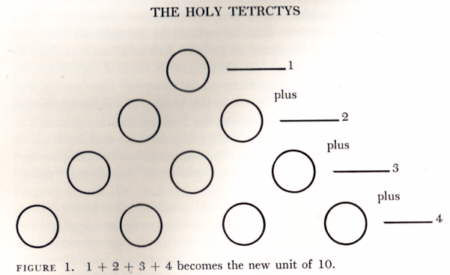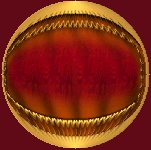Some "Whats and Whys" of the Elements © Julian Kenwick 2003
Many people who are interested in esoteric matters have received a scientific or technical education in the late twentieth century and therefore they have acquired certain mental habits. We tend to discount the reality of anything which we judge to have been merely "made up". If words are being used in any discussion to refer to things which are "fictional" then we would like this to be said early on and clearly.
There are times in speaking, nevertheless, when it is not a simple thing to judge whether the subject or object of a verbal expression actually "exists" in any sort of "objective" sense. For example, if a telescope is focused on an object at a distance of a million miles, we can talk about the focal point of the instrument as being at that distance, but we are really talking about a set of arrangements. If we arrange a few milk bottles in a circle or a square, we say that the geometric form of the arrangement is real or exists, but we know that this is a special kind of reality, one of definition and circumstance .
Another way of approaching such problems is to think about computer programs and about classes of things in mathematics. In these fields of activity, "things" are created and cause real effects, but their reality remains in the realms of the virtual and the contextual.
As students of occult or esoteric matters, we will repeatedly encounter the concept of the Elements; whether in the Western Mysteries as Air, Earth, Fire, and Water (plus the Quintessence-- literally the"fifth element " ) or in the Chinese system as Fire, Water, Wood, Metal, and Earth. These concepts are used as organizing principles in Astrology, Magic, and Divination. We will notice that they are not the same kinds of elements spoken of by science as belonging to the Periodic Table of atoms. It will become clear to us that we are talking about sets or classifications when we speak of these esoteric Elements, but we may wonder why they were chosen as fundamental organizers and whether other schemes might have been just as effective .
We may use the words "forces" or "energies" to describe the Elements, but they are surely not in the same category of reality as the electricity and radioactivity of modern physics. Even so, if we think about how some other things, for example, Numbers, seem to work in our experience, we may feel a little more comfortable about calling the Elements "forces ".
Numbers are really quite odd, after all. Everywhere you look , there they are. Two hands. Ten fingers. One angry pit-bull. They are inescapable. There is even evidence that animals, especially some birds, can do what we would call simple arithmetic. It appears that numbers are non-physical "somethings" that somehow control or organize the physical world for us.
It also seems that they are inside our heads just as much as being "out there" in the world. After all, it is up to us to see, for example, two pairs of shoes instead of one group of four shoes - even though the number of shoes has a physical reality as more than three and less than five. The Greek philosopher Pythagoras based his mystical interpretation of reality on just such numerical considerations. It seems that numbers are both inside us and outside us, both hard wired into our brains and inescapably present in the world. And they "do" things, in a way - they have effects. It would be nice if we could feel that the Elements are rather like numbers. Is there any evidence that they are?
As far as the Elements being "hard wired" into our brains, it is interesting that the famous psychiatrist Carl Jung said that we have four "functions" in our psychological makeup, which he called Thinking, Feeling, Sensing, and Intuiting. He also spoke of a fifth, a "transcendent" function. He noted that when people all over the world had "religious " visions, they often saw circular images divided into four sections. Many aboriginal and tribal cultures also attribute spiritual importance to the four directions of space.
Another indication of the power of fourness within our psyches can be found in the research of Dr. Max Luscher . He did experiments with thousands of people all over the world and found that the four primary colors Red, Yellow, Green, and Blue affected peoples bodies and feelings in predictable and consistent ways.
Esoteric students are able to correlate the four colors of Luscher and the four functions of Jung`s psychology easily and directly with the traditional qualities of the Elements. This helps us to believe that there is more than simple invention- for- no- reason taking place when we use this way of classifying things. We are emboldened to apply this system to many things, such as the seasons and the stages of human life. In the Middle Ages, the great scholar Athanasius Kircher went so far as to identify four letter Names of God in seventy two languages .
Of course , other numbers are also seen as sacred, especially the numbers three and seven. Jung spoke of the frequent references in Alchemy to the "three plus one ", and in Cabala the directions are supplemented by above, below, and within the centre, to arrive at seven. Thus we still seem to take fourness as a kind of home base of comparison. The Holy Tetractys diagram of Pythagoras showed the number Ten as a triangular group of dots composed of four rows.

The appropriateness of fourness as an organizing principle seems to be supported by aspects of our inner psychological structure---but what about the outer world ? Why not adapt the modern idea that the world is best described by the one hundred or so kinds of chemical atoms?
Well, for one thing, as esoteric students we are operating under the premise that there is a no real division between our inner selves and the external world. We believe the Hermetic statement "as above ,so below" which in more modern language means "that which is within is like that which is without". We think that our "microcosm" or little "inner" world is like the "macrocosm" our big outer world.
When we experience the outer world, all we find there are four states of physical matter combined in various ways-things which are solids, liquids, gases, radiating energies, or mixtures of these. Even the chemical atoms of the Periodic Table fall into these categories. So we look inside and we find the Elements and we look outside and we find the Elements. Even Classical physics allows only four forces, the electromagnetic, the strong force, the weak force, and gravitation.
The latest Quantum Physics states that our awareness directly influences the processes of the outer world, and we do not find this to be surprising . The student of Tarot will find that the Elements as reflected in the four Suits are a key principle which will enable a deep understanding of the many different esoteric systems from which the meanings of the cards are historically derived.

















